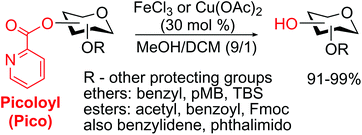Abstract
The picoloyl ester (Pico) has proven to be a versatile protecting group in carbohydrate chemistry. It can be used for the purpose of stereocontrolling glycosylations via an H-bond-mediated Aglycone Delivery (HAD) method. It can also be used as a temporary protecting group that can be efficiently introduced and chemoselectively cleaved in the presence of practically all other common protecting groups used in synthesis. Herein, we will describe a new method for rapid, catalytic, and highly chemoselective removal of the picoloyl group using inexpensive copper(II) or iron(III) salts.

- This article is part of the themed collection: Chemical Biology in OBC


 Please wait while we load your content...
Please wait while we load your content...
